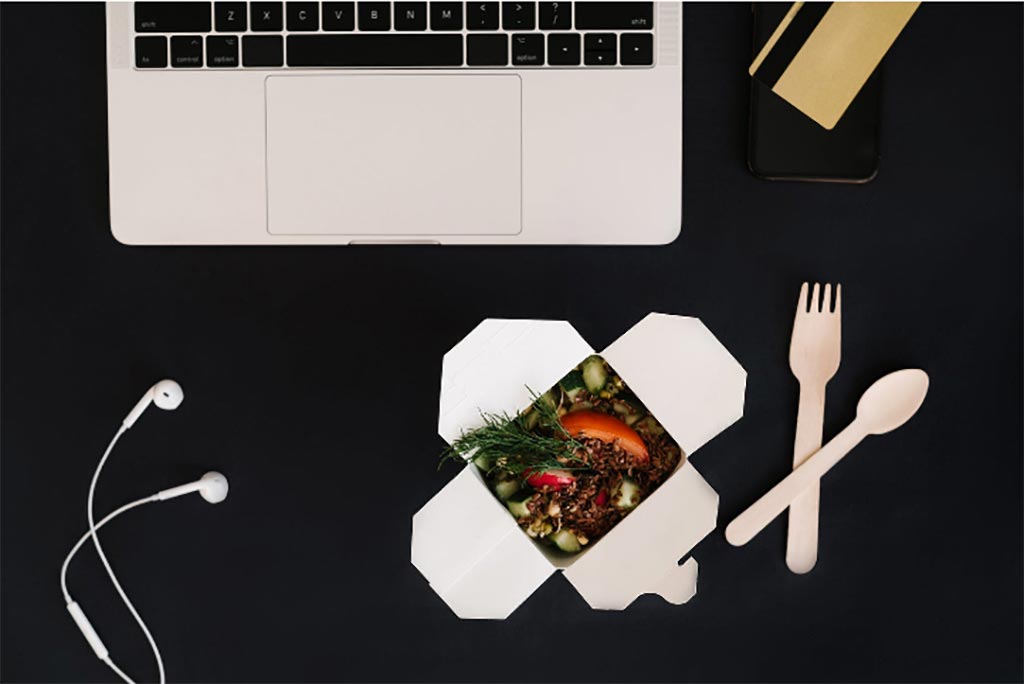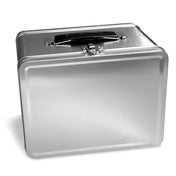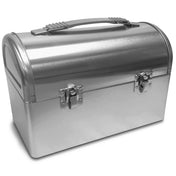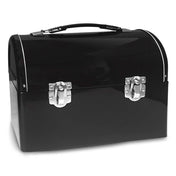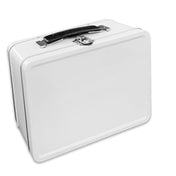When I first started working in an office full-time, my favorite part of the day was walking around Midtown Manhattan and marveling at the food choices available to me. Within a three-block radius, there were more than 20 eateries from which I could buy breakfast, lunch, or coffee – and for my first few weeks on the job, that’s precisely what I did.
I’d start each day with a pit stop at the nearby Starbucks for a morning latte. At lunchtime, I’d wander into a different deli or to-go cafe and buy whatever tempted me – sometimes soup, sometimes salad, and sometimes both.
After about a month of treating myself to store-bought coffee and prepared lunches, I got my first credit card bill since starting my job, and it was a real eye-opener. I discovered that over the course of just three to four weeks, I’d managed to spend nearly $200 on food and beverages alone.
From that moment on, I changed my ways. Instead of buying lunch every day, I packed my own soup or sandwich and brought it with me to work four days per week. I allowed myself one treat day a week, where I’d purchase something fresh or go out to lunch with coworkers to socialize and commiserate.
Additionally, I stopped purchasing $3 lattes at Starbucks and instead starting buying my morning coffee from the street cart outside my building, where I could snag a large cup for only $1. Those concessions, coupled with smart lunch-packing strategies, helped me reduce my monthly spend on coffee and lunch to just $80.
Bringing Food from Home
According to Forbes, the average American spends $936 annually on store-bought lunches alone. Here’s how much you can save by taking the time to bring in your own food and beverages instead.
Coffee
Store-bought coffee has one of the highest price markups out there. You might pay anywhere from $1.50 to $2.50 or more for a hot cup of Joe from your favorite coffee shop, whether it’s a mom-and-pop store or a national chain. Want a latte or flavored concoction? Expect to shell out a minimum of $3.
This is a lot to pay considering the fact that you can make your own instant coffee at home for $0.05 per cup. If you want brewed coffee instead of instant, you need to make a one-time investment in a coffee maker, which should cost $25 to $100.
From there, the cost to brew coffee at home is between $0.60 and $0.75 per cup depending on how strong you like it and whether you prefer to flavor it with creamer or sugar or both. If you normally pay $2 for your morning coffee from a shop, you can save $1.25 to $1.40 per day by brewing it at home.
Total Monthly Savings on Coffee: $30 to $50 or more
Total Yearly Savings: $360 to $600 or more
Breakfast
Many people who work outside the house leave early in the morning and prefer to pick up breakfast on the way to the office. However, buying breakfast from an eatery can be costly:
- Bagels. A bagel with butter or cream cheese usually costs $1.25 to $3.00. You can save $0.75 to $1 or more per day by prepping your own bagel at home.
- Muffins. Muffins typically cost $1.50 to $4 depending on where you live. You can save more than $1 each day by bringing in your own muffin from home.
- Egg and Cheese Sandwiches. You’ll usually pay $2.50 to $4 or more for an egg and cheese sandwich on a bagel or roll. You can save $1 to $3 per day by making your own.
- Oatmeal. A cup of oatmeal generally costs $2.50 to $4 when purchased from a cafe or deli. You can save $2 to $3 or more – depending on what you add to it – by making instant oatmeal at home.
Total Monthly Savings on Breakfast: $15 to $75 or more
Total Yearly Savings: $180 to $900 or more
Lunch
When it comes to buying food during the workday, lunch is usually most people’s largest expense. Consider the cost of the following popular lunch items when purchased from delis, cafes, or other to-go establishments:
- Soup. A 12-ounce cup can cost anywhere from $3 to $6 or more. You can make a pot of soup for $10 or less with enough for eight or more lunches and easily save $5 per day.
- Sandwiches and Wraps. A sandwich or wrap can cost anywhere from $5 to $10 or more depending on what’s in it. If your usual turkey sandwich with lettuce, cheese, and tomatoes costs $7.50, you can make your own for $3 or less and save $4.50 per day.
- Salad. Prepared salads can cost $5 to $10 or more depending their ingredients. Many delis and cafes these days feature make-your-own salad bars, where salad prices are determined either by weight or by specific ingredient, but of course there’s always a markup involved. You can prepare a salad at home with lettuce, tomato, peppers, corn, and grilled chicken for $3 to $5 and save more than $5 on what you’d pay at a deli or cafe for the same amount of food.
- Pasta or Rice Bowls. These typically cost between $8 and $12 depending on their contents. You can make a large batch of pasta with vegetables and chicken for $10 with enough for six lunches, or whip up your own rice and beans concoction for less than $10 with enough for six lunches. By doing so, you save over $5 per day.
While making your own lunches requires extra time and effort on your part, as you need to do the cooking and prep work at home, meals like soup and pasta can be made in large batches over the weekend. Sandwiches don’t tend to do as well when made in advance, but they’re very quick to put together before you leave for work in the morning.
You can also chop up vegetables for salad in advance to save time during the week, but if you’re planning to dress your salad, you should wait until the morning to do so – or better yet, pack in a separate container. Dressing your salad too far in advance can make it soggy and unappetizing.
The Downside of Bringing Lunch
There are some drawbacks to bringing your lunch in every day, the first of which is getting stuck working through lunch. This happened to me. Since I packed my own lunch most days and didn’t need to leave the building to get food, I’d reheat my meal in the kitchen and eat at my desk while hoping to use the time to check my personal email or read stories of interest online.
However, what happened was that people would see me at my desk, come over, and interrupt my downtime with work-related requests. Because there was no break room or lunch room, I had no escape within the confines of my office, and it often made for an aggravating situation.
If you’re in a similar situation, try doing the following:
- Eat at a nearby park if the weather is nice.
- Eat in your car if you drive to work. It may not be ideal, but at least you’ll get to enjoy your lunch in peace.
- Try politely asking your managers and colleagues to respect the fact that you’re on a well-deserved break.
If you bring in your own lunch, you may also run into the issue of limited fridge space. If this is the case in your office, you can try packing your lunch in a cooler with ice packs and storing it at your desk until you’re ready to eat. This is especially doable if you drive to work and don’t have to worry about lugging a cooler on public transportation.
One additional problem that may creep up if you opt to pack your own lunch is having it stolen. If you buy your lunch at a food establishment and bring it directly back to your desk, you eliminate the opportunity for would-be thieves to get their hands on your stash. However, if you leave it sitting in the fridge, it could get taken.
Though you’d hope this wouldn’t be an issue at your place of work, it has been known to happen. To avoid it, be sure to label your lunch properly and put it in a sealed bag that isn’t see-through. Office lunch thieves are far less likely to take your food if they can’t actually see what it is they’re stealing.
Finally, bringing in your lunch everyday might limit your opportunity to socialize and build relationships with coworkers. If your colleagues are constantly going out to lunch together and you opt to pass on their invitations, you could lose out on the chance to make new friends or improve your working relationships. Also, keep in mind that sometimes your best laid plans to save money on lunch can go awry, as you may find yourself obliged to attend birthday or celebratory lunches for coworkers on a regular basis.
If you are going to eat lunch at a restaurant once in a while, look for online deals. Restaurant.com allows you to buy restaurant certificates at a discount so that you might pay just $20 for $40 in food.
Total Monthly Savings on Lunch: $100 to $200 or more
Total Yearly Savings: $1,200 to $2,400 or more
Snacks
Some people need an afternoon pick-me-up to make it through the workday, but buying your snack from an office vending machine or corner newsstand could mean spending far more than you have to.
- Candy Bars, Granola Bars, and Chips. An individual candy bar, granola bar, or bag of chips costs $1 to $1.50 when purchased from a vending machine or city-based newsstand. At the supermarket, a box of six granola bars costs $3 to $5, a large-sized bag of chips with eight servings costs $2.50 to $4, and a six-pack of candy bars costs $3 or less. You can save $0.50 to $0.70 per serving by purchasing your snacks at a grocery store and bringing them with you to work.
Total Monthly Savings on Snacks: $10 or more
Total Yearly Savings: $120 or more
Sodas and Beverages
Some people enjoy drinking soda, seltzer, and bottled water with lunch or as an afternoon refreshment, but buying these items from a deli, newsstand, or vending machine is almost always considerably more expensive than buying them from a supermarket.
- Soda and Seltzer. A can of soda or seltzer typically costs $1 or more from a vending machine or newsstand. At the supermarket, a 12-pack of soda cans costs $4 or less, and a 12-pack of seltzer cans costs $3 or less. You can save $0.67 to $0.75 per can by buying your drink of choice at the grocery store.
- Water. A bottle of water usually costs $1 or more from a vending machine or newsstand, whereas a 24-count case of bottled water costs $4 or less at the supermarket. You can save $0.83 per bottle if you purchase your water at the grocery store. If your office has a water cooler, you can save even more money by purchasing a reusable water bottle and refilling it at the cooler as needed. A reusable water bottle costs $5 to $15 as a one-time purchase. If your office doesn’t offer clean, filtered water, consider buying a large reusable bottle, filling it up at home with distilled water, and bringing it with you to save money.
Total Monthly Savings on Beverages, Assuming One Per Day: $13 to $16 or more
Total Yearly Savings: $156 to $192 or more
Final Word
By bringing in your own coffee, breakfast, lunch, snacks, and beverages every day, you can save anywhere from $2,000 to $4,200 or more over the span of an entire year. And taking your own food to work is not just economical – in many cases, it’s also the more health-conscious option. When you prepare your own meals, you can use healthier, more natural ingredients and reduce your chances of overeating due to better portion control.
Remember, when it comes to buying food versus bringing it to work, it doesn’t have to be all or nothing. It’s not a crime to treat yourself once per week or on occasion, especially if there’s a particular food item or beverage you really enjoy but can’t easily make yourself.
Do you bring in your own food from home to save money? What are some of your favorite lunches to make from scratch?
Original article by Maurie Backman appears on Money Crashers.
Photo by Mikhail Nilov of Pexels

